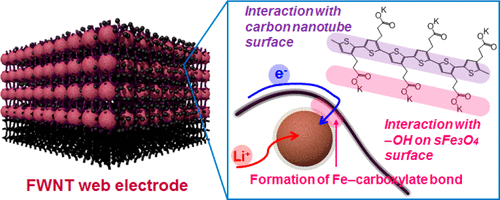Our official English website, www.x-mol.net, welcomes your
feedback! (Note: you will need to create a separate account there.)
Carbon Nanotube Web with Carboxylated Polythiophene “Assist” for High-Performance Battery Electrodes
ACS Nano ( IF 15.8 ) Pub Date : 2018-01-16 00:00:00 , DOI: 10.1021/acsnano.7b08918 Yo Han Kwon 1 , Jung Jin Park 2 , Lisa M. Housel 3 , Krysten Minnici 1 , Guoyan Zhang 1 , Sujin R. Lee 4 , Seung Woo Lee 5 , Zhongming Chen 6 , Suguru Noda 6 , Esther S. Takeuchi 3, 7, 8 , Kenneth J. Takeuchi 3, 7 , Amy C. Marschilok 3, 7, 8 , Elsa Reichmanis 1, 4, 9
ACS Nano ( IF 15.8 ) Pub Date : 2018-01-16 00:00:00 , DOI: 10.1021/acsnano.7b08918 Yo Han Kwon 1 , Jung Jin Park 2 , Lisa M. Housel 3 , Krysten Minnici 1 , Guoyan Zhang 1 , Sujin R. Lee 4 , Seung Woo Lee 5 , Zhongming Chen 6 , Suguru Noda 6 , Esther S. Takeuchi 3, 7, 8 , Kenneth J. Takeuchi 3, 7 , Amy C. Marschilok 3, 7, 8 , Elsa Reichmanis 1, 4, 9
Affiliation

|
A carbon nanotube (CNT) web electrode comprising magnetite spheres and few-walled carbon nanotubes (FWNTs) linked by the carboxylated conjugated polymer, poly[3-(potassium-4-butanoate) thiophene] (PPBT), was designed to demonstrate benefits derived from the rational consideration of electron/ion transport coupled with the surface chemistry of the electrode materials components. To maximize transport properties, the approach introduces monodispersed spherical Fe3O4 (sFe3O4) for uniform Li+ diffusion and a FWNT web electrode frame that affords characteristics of long-ranged electronic pathways and porous networks. The sFe3O4 particles were used as a model high-capacity energy active material, owing to their well-defined chemistry with surface hydroxyl (−OH) functionalities that provide for facile detection of molecular interactions. PPBT, having a π-conjugated backbone and alkyl side chains substituted with carboxylate moieties, interacted with the FWNT π-electron-rich and hydroxylated sFe3O4 surfaces, which enabled the formation of effective electrical bridges between the respective components, contributing to efficient electron transport and electrode stability. To further induce interactions between PPBT and the metal hydroxide surface, polyethylene glycol was coated onto the sFe3O4 particles, allowing for facile materials dispersion and connectivity. Additionally, the introduction of carbon particles into the web electrode minimized sFe3O4 aggregation and afforded more porous FWNT networks. As a consequence, the design of composite electrodes with rigorous consideration of specific molecular interactions induced by the surface chemistries favorably influenced electrochemical kinetics and electrode resistance, which afforded high-performance electrodes for battery applications.
中文翻译:

碳纳米管网,带羧基化聚噻吩“辅助”剂,用于高性能电池电极
碳纳米管(CNT)腹板电极包含磁铁矿球和通过羧化共轭聚合物聚[3-(4-丁酸钾)噻吩](PPBT)连接的薄壁碳纳米管(FWNT),旨在证明其带来的好处合理考虑电子/离子传输以及电极材料成分的表面化学性质。为了最大程度地提高传输性能,该方法引入了单分散球形Fe 3 O 4(sFe 3 O 4),以实现均匀的Li +扩散和FWNT网状电极框架,该框架具有长距离电子路径和多孔网络的特性。sFe 3 O 4由于它们具有表面羟基(-OH)官能团的明确定义的化学性质(可轻松检测分子相互作用),因此它们被用作模型的高容量能量活性材料。具有BT共轭主链和被羧酸酯部分取代的烷基侧链的PPBT与FWNT富含π电子和羟基化的sFe 3 O 4表面相互作用,从而能够在各个组分之间形成有效的电桥,从而有助于提高效率。电子传输和电极稳定性。为了进一步诱导PPBT和金属氢氧化物表面之间的相互作用,将聚乙二醇涂覆在sFe 3 O 4上颗粒,使材料易于分散和连通。另外,将碳颗粒引入到网状电极中使sFe 3 O 4聚集最小化,并提供了更多的多孔FWNT网络。因此,在设计复合电极时要严格考虑表面化学物质引起的特定分子相互作用,从而对电化学动力学和电极电阻产生有利影响,从而为电池应用提供了高性能的电极。
更新日期:2018-01-16
中文翻译:

碳纳米管网,带羧基化聚噻吩“辅助”剂,用于高性能电池电极
碳纳米管(CNT)腹板电极包含磁铁矿球和通过羧化共轭聚合物聚[3-(4-丁酸钾)噻吩](PPBT)连接的薄壁碳纳米管(FWNT),旨在证明其带来的好处合理考虑电子/离子传输以及电极材料成分的表面化学性质。为了最大程度地提高传输性能,该方法引入了单分散球形Fe 3 O 4(sFe 3 O 4),以实现均匀的Li +扩散和FWNT网状电极框架,该框架具有长距离电子路径和多孔网络的特性。sFe 3 O 4由于它们具有表面羟基(-OH)官能团的明确定义的化学性质(可轻松检测分子相互作用),因此它们被用作模型的高容量能量活性材料。具有BT共轭主链和被羧酸酯部分取代的烷基侧链的PPBT与FWNT富含π电子和羟基化的sFe 3 O 4表面相互作用,从而能够在各个组分之间形成有效的电桥,从而有助于提高效率。电子传输和电极稳定性。为了进一步诱导PPBT和金属氢氧化物表面之间的相互作用,将聚乙二醇涂覆在sFe 3 O 4上颗粒,使材料易于分散和连通。另外,将碳颗粒引入到网状电极中使sFe 3 O 4聚集最小化,并提供了更多的多孔FWNT网络。因此,在设计复合电极时要严格考虑表面化学物质引起的特定分子相互作用,从而对电化学动力学和电极电阻产生有利影响,从而为电池应用提供了高性能的电极。











































 京公网安备 11010802027423号
京公网安备 11010802027423号